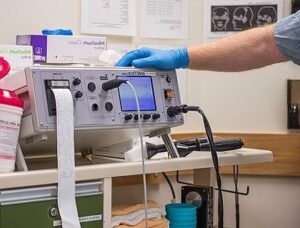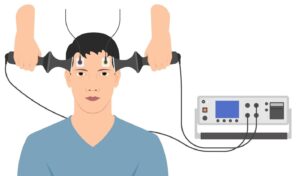Last updated on September 26th, 2024 at 04:19 pm
Electroconvulsive Therapy (ECT), also known as electroshock therapy, is a medical procedure that involves inducing controlled seizures in the brain to treat certain mental illnesses, particularly severe depression and some forms of schizophrenia. Despite its controversial history, ECT has evolved over the years to become a safer and more controlled therapeutic option for individuals who do not respond well to other treatments.
Electroconvulsive Therapy (ECT) sessions are typically administered under anaesthesia, and muscle relaxants are used to prevent the intense muscle contractions that can occur during a seizure. During the procedure, electrodes are placed on the patient’s scalp, and an electrical current is passed through the brain, inducing a brief seizure that lasts for about 20 to 60 seconds. The specific mechanism through which ECT exerts its therapeutic effects is not fully understood, but it is believed to involve neurotransmitter changes and alterations in brain circuitry.
ECT is usually administered in a series of treatments, with several sessions taking place over a few weeks. The number of sessions required varies depending on the individual’s response to treatment and the severity of their condition. In some cases, maintenance ECT sessions may be recommended to prevent relapse.
Electroconvulsive Therapy
Electroconvulsive Therapy (ECT) has a complex history that dates back to the early 20th century. It was first introduced in the 1930s as a treatment for various psychiatric disorders. However, its early use lacked the safety measures and ethical considerations that are standard in modern medical practice. ECT was portrayed negatively in popular culture and media, leading to a stigmatized perception.
Read: What is Generic Medicine?
Modern Advancements
Over the decades, ECT has evolved significantly in terms of safety, administration, and patient care. Advances in medical technology, anaesthesia, and monitoring techniques have transformed ECT into a safer and more controlled procedure. Today, ECT is conducted in specialized medical settings by trained professionals, and stringent protocols are in place to ensure patient safety and well-being.

Electroconvulsive Therapy Procedure and Mechanism
During an Electroconvulsive Therapy (ECT) session, the patient is given a general anaesthetic to ensure they are unconscious and do not experience any pain. Additionally, muscle relaxants are administered to prevent the intense convulsions that historically caused physical injuries. Electrodes are placed on specific locations on the patient’s scalp, typically on both sides of the head, and a carefully controlled electrical current is applied for a brief period.
This stimulation triggers a seizure that lasts for about 20 to 60 seconds. The exact mechanism by which ECT exerts its therapeutic effects is not fully understood, but several theories exist. It is believed that the induced seizure affects neurotransmitter levels in the brain, particularly serotonin, norepinephrine, and dopamine, which play vital roles in mood regulation. ECT may also influence the neuroplasticity of the brain, leading to changes in neural circuits and connectivity.
Electroconvulsive Therapy Indications and Effectiveness
ECT is primarily used to treat severe depressive disorders, especially when they are accompanied by symptoms such as suicidal tendencies, severe agitation, or psychosis. It is also considered for individuals with treatment-resistant bipolar disorder and certain forms of schizophrenia.
ECT is usually recommended when other treatment options, including medication and psychotherapy, have not provided significant relief. Research suggests that ECT can lead to rapid improvements in severe psychiatric symptoms. It is particularly effective in cases where urgent intervention is needed or when individuals are unable to tolerate the side effects of medications.
> Consult a doctor and Order Medicine Online
Side Effects of Electroconvulsive Therapy
While modern ECT procedures are safer than their historical counterparts, they can still cause certain side effects. Temporary memory loss and confusion are common, especially immediately following the treatment. However, these side effects tend to improve as the patient recovers from the procedure. More serious side effects, such as cardiovascular complications or permanent memory impairment, are rare due to advancements in anaesthesia and monitoring.

Ethical and Societal Concerns
Ethical concerns have historically surrounded ECT due to its portrayal in media, historical misuse, and the stigma attached to mental health treatments. However, contemporary ECT practices prioritize patient safety, informed consent, and a careful evaluation of risks and benefits. Mental health professionals ensure that patients fully understand the procedure before giving their consent.
Conclusion:
Electroconvulsive Therapy, while historically controversial, has evolved into a medical procedure that offers relief to individuals suffering from severe mental health disorders. Under the guidance of trained professionals, modern ECT can provide rapid symptom improvement and an improved quality of life for those who have not responded well to other treatments. The ongoing advancements in psychiatric care and research continue to shape the understanding and application of ECT as a therapeutic option.
FAQs on Electroconvulsive Therapy
Q1. What is Electroconvulsive Therapy?
Electroconvulsive therapy (ECT) is a medical procedure used to treat severe mental health conditions, particularly major depressive disorder, bipolar disorder, and some forms of schizophrenia. During ECT, controlled electric currents are applied to the brain, inducing a brief seizure. The procedure is typically administered under general anaesthesia and muscle relaxants to minimize discomfort and prevent physical convulsions. ECT is considered when other treatment options have been ineffective or when rapid intervention is necessary due to the severity of the illness.
Q2. How does electroconvulsive therapy work?
The exact mechanism of action of ECT is not fully understood, but it is believed to involve changes in brain chemistry and neural pathways. The induced seizure is thought to impact neurotransmitter levels, such as serotonin and dopamine, which play a significant role in mood regulation. Additionally, ECT may influence brain circuitry and neuroplasticity, leading to alterations in neural connections. These changes are believed to contribute to the therapeutic effects of ECT on severe psychiatric symptoms.
Q3. What conditions is ECT used to treat?
ECT is primarily used to treat severe mental health conditions that have not responded well to other treatments. These conditions include severe depressive disorders, especially those with features like suicidality, psychosis, or agitation. ECT is also considered for individuals with treatment-resistant bipolar disorder and certain types of schizophrenia. Mental health professionals carefully assess each case to determine if ECT is an appropriate treatment option based on the individual’s medical history, symptom severity, and treatment goals.
Q4. What are the potential side effects and risks of ECT?
ECT, like any medical procedure, carries potential risks and side effects. Common side effects include short-term memory loss and confusion immediately after the procedure, which usually resolves in the days or weeks following treatment. More serious side effects, such as cardiovascular complications, permanent memory impairment, or fractures due to muscle contractions, are rare but possible. Advances in anaesthesia and monitoring techniques have minimized the risk of severe adverse events. The benefits and risks of ECT are carefully evaluated by medical professionals before recommending the treatment.
Related Links:
